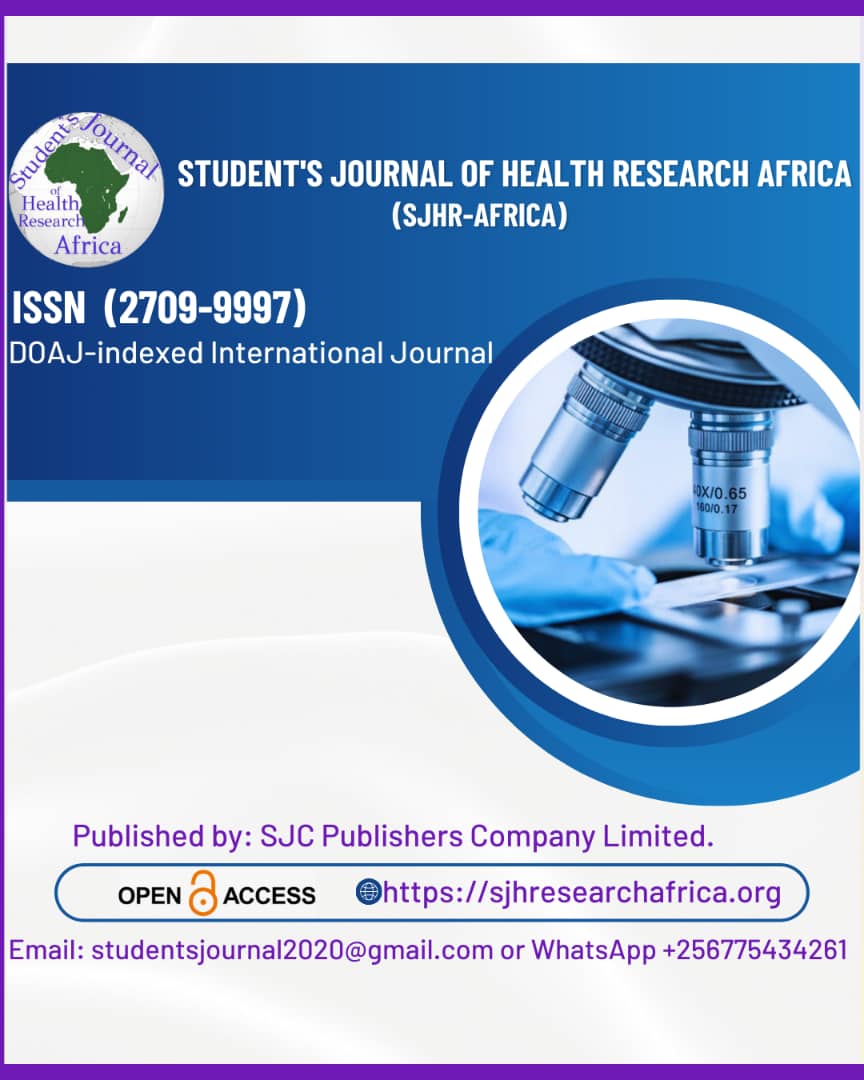Prevalence of asymptomatic carriage of methicillin-resistant Staphylococcus aureus (MRSA) among healthcare workers and its infection control implications: A retrospective observational study.
DOI:
https://doi.org/10.51168/sjhrafrica.v6i9.2087Keywords:
Methicillin-resistant Staphylococcus aureus, Healthcare Workers, Carriage, Infection ControlAbstract
Background
In 1961, a year after semisynthetic penicillin was introduced, methicillin-resistant S. aureus (MRSA) isolates were first identified. They are resistant to all penicillin and β-lactam medicines, and this has led to their spread in both hospital and community settings.
Objectives
Determining the frequency of MRSA colonization among healthcare professionals and evaluating related risk factors were the study's objectives.
Materials and methods
It was a retrospective, observational study. The study was carried out at Nalanda Medical College and Hospital (NMCH), Patna, Bihar, India. The study data that was retrieved was for one year, i.e., from February 2023 to January 2024. Data from 220 participants were retrieved for the study. Healthcare professionals working in different intensive care units (ICUs) and high-risk hospital departments, including physicians, nurses, attendants, housekeeping personnel, and technicians, met the study's inclusion criteria.
Results
The participants' average age was 31.4 ± 7.2 years, and 71.3% of them were female. The largest group was made up of nurses (46.4%) and doctors (26.8%). 13.6% of healthcare workers were found to have MRSA carriage. Workers with less education (p = 0.03) and staff nurses (p = 0.002) had considerably higher carriage. The neurosurgical intensive care unit had the greatest percentage of MRSA carriers (13.3%). Gender did not significantly correlate (p = 0.18).
Conclusion
The study found that MRSA colonization was significantly more common among healthcare workers, with staff nurses and individuals with less education having higher rates. MRSA carrier rates were also greater in certain ICU sites, such as the surgical and neurosurgery ICUs.
Recommendations
For early detection and prevention, healthcare staff must undergo routine MRSA screening, particularly in high-risk settings like intensive care units.
References
Foster TJ. The Staphylococcus aureus "superbug". The Journal of Clinical Investigation. 2004 Dec 15;114(12):1693-6. https://doi.org/10.1172/JCI23825
Moellering Jr RC. MRSA: the first half century. Journal of Antimicrobial Chemotherapy. 2012 Jan 1;67(1):4-11. https://doi.org/10.1093/jac/dkr437
World Health Organization. WHO bacterial priority pathogens list, 2024: bacterial pathogens of public health importance, to guide research, development, and strategies to prevent and control antimicrobial resistance. World Health Organization; 2024 May 17.
Giri S, Ghimire A, Mishra A, Acharya K, Kuikel S, Tiwari A, Mishra SK. Prevalence of methicillin-resistant Staphylococcus aureus carriage among healthcare workers in South Asia in non-outbreak settings: A systematic review and meta-analysis. American Journal of Infection Control. 2023 Feb 1;51(2):184-93. https://doi.org/10.1016/j.ajic.2022.06.001
Hebbar S, Nayak BS, Bhat AK. Methicillin-Resistant Staphylococcus Aureus Carrier Status among Indian Healthcare Workers: A Systematic Review and Meta-Analysis. Indian Journal of Forensic Medicine & Toxicology. 2021 Apr 1;15(2). https://doi.org/10.37506/ijfmt.v15i2.14327
Cirkovic I, Stepanovic S, Skov R, Trajkovic J, Grgurevic A, Larsen AR. Carriage and genetic diversity of methicillin-resistant Staphylococcus aureus among patients and healthcare workers in a Serbian university hospital. PLoS One. 2015 May 20;10(5):e0127347. https://doi.org/10.1371/journal.pone.0127347
Acton DS, Tempelmans Plat-Sinnige MJ, van Wamel W, de Groot N, van Belkum A. Intestinal carriage of Staphylococcus aureus: how does its frequency compare with that of nasal carriage and what is its clinical impact?. European journal of clinical microbiology & infectious diseases. 2009 Feb;28(2):115-27. https://doi.org/10.1007/s10096-008-0602-7
Albrich WC, Harbarth S. Health-care workers: source, vector, or victim of MRSA?. The Lancet infectious diseases. 2008 May 1;8(5):289-301. https://doi.org/10.1016/S1473-3099(08)70097-5
Safdar N, Bradley EA. The risk of infection after nasal colonization with Staphylococcus aureus. The American journal of medicine. 2008 Apr 1;121(4):310-5. https://doi.org/10.1016/j.amjmed.2007.07.034
Dow G, Field D, Mancuso M, Allard J. Decolonization of Methicillin‐Resistant Staphylococcus aureus during Routine Hospital Care: Efficacy and Long‐Term Follow‐Up. Canadian Journal of Infectious Diseases and Medical Microbiology. 2010;21(1):38-44. https://doi.org/10.1155/2010/590530
Ayliffe GA. The progressive intercontinental spread of methicillin-resistant Staphylococcus aureus. Clinical infectious diseases. 1997 Jan 1;24(Supplement_1):S74-9. https://doi.org/10.1093/clinids/24.Supplement_1.S74
Khanal R, Sah P, Lamichhane P, Lamsal A, Upadhaya S, Pahwa VK. Nasal carriage of methicillin-resistant Staphylococcus aureus among health care workers at a tertiary care hospital in Western Nepal. Antimicrobial resistance and infection control. 2015 Oct 9;4(1):39. https://doi.org/10.1186/s13756-015-0082-3
Vonberg RP, Stamm-Balderjahn S, Hansen S, Zuschneid I, Rüden H, Behnke M, Gastmeier P. How often do asymptomatic healthcare workers cause methicillin-resistant Staphylococcus aureus outbreaks? A systematic evaluation. Infection Control & Hospital Epidemiology. 2006 Oct;27(10):1123-7. https://doi.org/10.1086/507922
Hawkins G, Stewart S, Blatchford O, Reilly J. Should healthcare workers be screened routinely for meticillin-resistant Staphylococcus aureus? A review of the evidence. Journal of Hospital Infection. 2011 Apr 1;77(4):285-9. https://doi.org/10.1016/j.jhin.2010.09.038
Dulon M, Haamann F, Nienhaus A. Involvement of occupational physicians in the management of MRSA-colonised healthcare workers in Germany survey. Journal of Occupational Medicine and Toxicology. 2013 May 27;8(1):16. https://doi.org/10.1186/1745-6673-8-16
Lindsay JA. Hospital-associated MRSA and antibiotic resistance-what have we learned from genomics?. International Journal of Medical Microbiology. 2013 Aug 1;303(6-7):318-23. https://doi.org/10.1016/j.ijmm.2013.02.005
Mehndiratta PL, Bhalla P, Ahmed A, Datta P. Colonization & infection with methicillin-resistant Staphylococcus aureus & its association with healthcare workers in a tertiary care hospital in India. Indian J Med Res. 2011;133(5):531-535.
Tiwari HK, Das AK, Sapkota D, Sivrajan K, Pahwa VK. Methicillin-resistant Staphylococcus aureus: prevalence and antibiogram in a tertiary care hospital in western Nepal. The journal of infection in developing countries. 2009 Oct 22;3(09):681-4. https://doi.org/10.3855/jidc.86
Dağtaş MZ, Ünal ÖK, editors. Ortopedik Cerrahide Cerrahi Alan İnfeksiyonu Risk Faktörleri. Akademisyen Kitabevi; 2020 Dec 17.
Kumar M, Aroor S, Mundkur S, Kumar S. Guillain-barré syndrome: a clinical study of twenty children. Journal of clinical and diagnostic research: JCDR. 2015 Jan 1;9(1):SC09. https://doi.org/10.7860/JCDR/2015/8344.5491
Albrich WC, Harbarth S. Health-care workers: source, vector, or victim of MRSA?. The Lancet infectious diseases. 2008 May 1;8(5):289-301. https://doi.org/10.1016/S1473-3099(08)70097-5
Downloads
Published
How to Cite
Issue
Section
License
Copyright (c) 2025 Nirmala Kumari, Sanjay Kumar, Rajesh Kumar, Satyendu Sagar

This work is licensed under a Creative Commons Attribution-NonCommercial-NoDerivatives 4.0 International License.





















